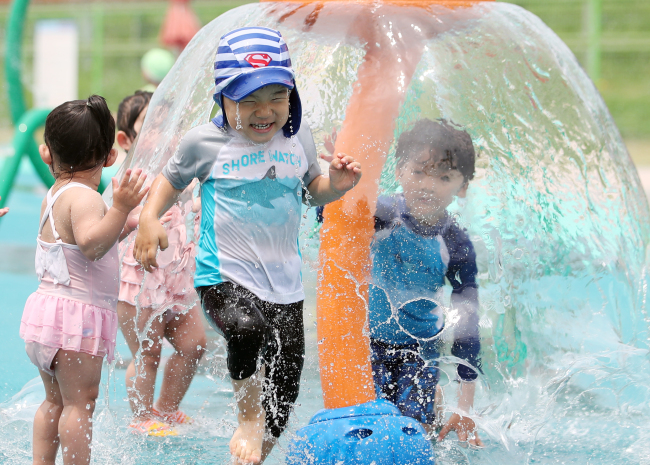Closet reorganization has long been a seasonal chore for South Koreans, but climate change is prompting some people to do away with the cumbersome task.
South Korea’s once distinctive four seasons, spread out almost evenly over 12 months, seem to be giving way to two long and seasons of extreme heat and cold, with short transition periods in between.
“I no longer put short-sleeved shirts into boxes. It feels like summer comes right after winter now,” said a 32-year-old office worker Kim Jin-hee.
 |
A child plays by a water fountain in Seoul. (Yonhap) |
It’s only mid-June, but it has been a while since Kim started carrying a handy fan in her bag for the commute, she added.
In fact, South Korea is experiencing an early arrival of sweltering summer heat right now, coupled with an extreme drought, which experts say are impacts of the climate change on the Korean Peninsula.
The season’s first heat advisory was issued on June 16 for Seoul, with a midday high soaring to 33 degrees Celsius in the capital. Nearly a month before that, the southern city of Daegu has seen the nation’s first issuance of the heat advisory.
Not surprisingly, air conditioners are becoming a must-have at home. And the sales of the appliance are not restricted to summer season.
According to local retail giant Lotte Hi-mart, the sales of air conditioners from January to May have shot up by 110 percent over the same period last year. Most number of air conditioners were sold in April, followed by March and May, Lotte said.
 |
(Yonhap) |
“We started receiving order reservations from January for those who want installation at home. If you order it now, it will take at least 3 weeks up to 2 months,” said Lotte Mart official.
But while some industries are enjoying their heyday, health concerns are rising along with heat-related illnesses.
As of this week, a total of 58 heat-related illnesses were reported across the country, according to the Ministry of Public Safety and Security.
Separate figure by the Centers for Disease Control and Prevention showed that at least 2 in 10 patients suffering from heat-related illnesses developed symptoms while indoors, advising citizens to be careful regardless of where they are during the summer heat wave.
Medical experts have long warned that rising global temperatures can impact public health because deadly heat can spread infectious diseases and even lead food shortages.
“Most believe that heat-related illnesses occur from being directly in the sun. But the biggest cause is the temperature where one is,” said Park Hee-jin, a professor of family medicine at Severance Hospital.
“Dehydration, dizziness and vomiting all occur as our body tries to adjust to the surrounding temperature. It is the most basic step to drink enough water to help the body adjust,” she said.
To protect health of citizens outdoor, Seocho-gu district office installed some 50 parasol umbrellas by pedestrian crossings in Seoul so passersby can stop and wait in the shade, providing oases in the desert-like concrete streets. The district office said it planned to install 60 more by end of this month.
The Seoul Metropolitan Government said it activated the main water fountain in Gwanghwamun Square on April 14 this year, earlier than the normal beginning of operations in May.
The capital’s public swimming pools by Han River are slated to open this weekend. Jejudo Island’s four beaches, including Hyeopjae Beach, will open this weekend as well, earlier than usual July opening.
By Kim Da-sol (
ddd@herladcorp.com)









